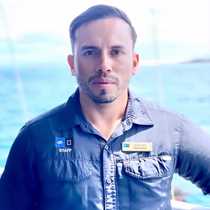Floreana Island
The very mysterious island of Floreana is located in the southern part of the archipelago. Floreana, also known as Charles, is covered with many extinct volcanic cones and at the same time, full of native and endemic species of flora. This particular Island is also known for one of the most intriguing human history chapters of the archipelago: from whalers to prisoners and even colonists; and from a toothless dentist to a self-proclaimed empress, back in 1929.
We started our daily expedition with an optional pre-breakfast landing on a colorful beach of olivine sand found at a visitor site known as Punta Cormorant. We walked along a large brackish lagoon where a few greater flamingos were spotted, as well as striated herons and wimbrels.
Following the trail further into the island, we arrived at a second beautiful beach of incredibly fine, white organic sand, one of the favorite nesting sites for Pacific green sea turtles. Several fresh nests were found, turtles were popping their heads continuously on the water and we were even lucky enough to find a turtle just finishing covering its eggs with sand and soon going back into the ocean. On the black lava rocks the colorful Sally Lightfoot crabs were sighted and some frigatebirds were patrolling the area, waiting for any turtle hatchlings to come out of their nests.
We came back aboard for breakfast while the ship navigated to a small offshore volcanic cone named Champion Islet, where we soon headed on an expedition to explore the underwater world. We sighted some sharks and many species of fish among the coral heads. Glass-bottom boat excursions were also offered for those who didn’t want to get wet but wanted to explore the underwater life.
Later we went searching for one of the rarest land birds of the Islands, the Floreana mockingbird. Once abundant on the main island, it was driven to extinction by cats, rats and other introduced predators; nowadays it’s only found on the satellite islets around the main island of Floreana. Following the rocky shores, we were amazed with the view: Opuntia cacti completely covered by yellow-orange flowers, like apples in a tree; swallow-tailed gulls feeding their young ones; sea lions resting on the rocks; marine iguanas feeding on the algae; and the always inquisitive brown noddy terns.
After midday, we offered kayaking as an option, followed by a visit to the famous Post Office Bay, where a barrel is still used for an old mail swap tradition going back to whaling days. Postcards were delivered and a few were collected. After keeping the ancient local mailing tradition, some Zodiac rides were offered to explore the bay and a sea lion colony where we were lucky to find four penguins sharing their habitat with some playful Galápagos sea Lions.
Before sunset, we ended our day with great stories of the mysterious island of Floreana, where human history, endemic species and nature in its purest stage were the highlights of another outstanding day in the enchanted archipelago.




